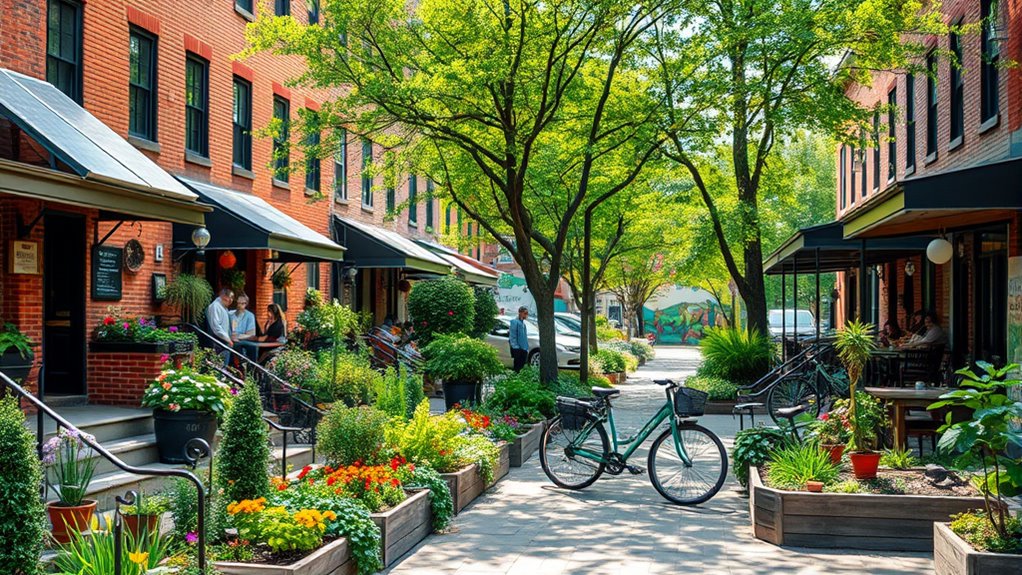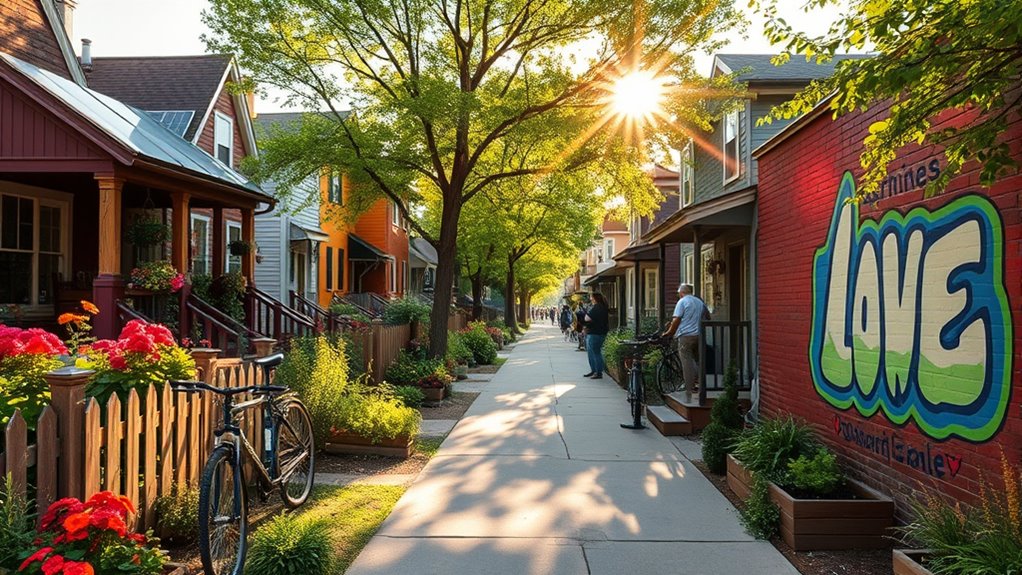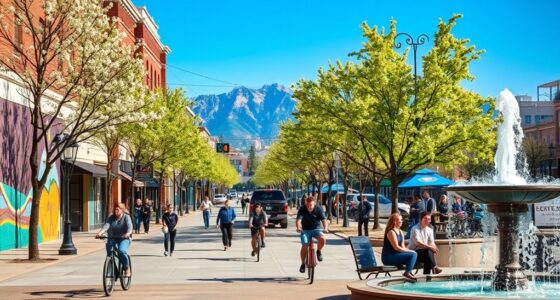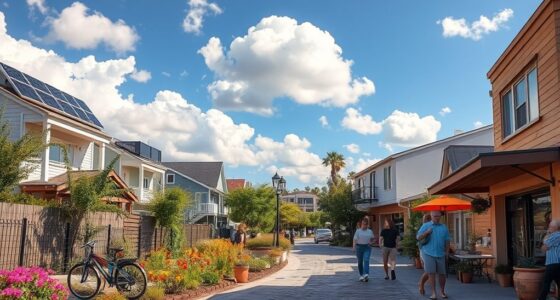In Philadelphia, you can explore vibrant sustainable neighborhoods like East Kensington, where urban farming and eco-friendly architecture come together. Check out community gardens, rooftop farms, and innovative buildings that enhance the local environment. You’ll find green spaces bursting with life and opportunities to engage in sustainability efforts. Plus, local cafes serve eco-conscious choices, making it easy to adopt healthier habits. There’s so much more to discover about these inspiring communities!
Key Takeaways
- Explore East Kensington for its urban farming initiatives and eco-friendly architecture that promote community engagement and sustainability.
- Visit local community gardens and rooftop farms to experience fresh produce and foster social ties among residents.
- Participate in community workshops and sustainability events that highlight responsible development and environmental health.
- Enjoy vibrant green spaces and innovative building designs that exemplify Philadelphia’s commitment to sustainable living.
- Stop by local cafes serving eco-conscious choices, like ginger lemon tea, to support sustainable practices in the neighborhood.

Have you ever wondered what makes a neighborhood truly sustainable? In Philadelphia, the answer often lies in a blend of urban farming and eco-friendly architecture. These elements work together to create vibrant communities that not only thrive today but also consider future generations. You’ll find that sustainable neighborhoods focus on minimizing their carbon footprint while fostering a sense of community.
When you explore the city, you can’t help but notice the rise of urban farming. From community gardens to rooftop farms, these green spaces provide fresh produce right where people live. You might even come across an initiative that allows locals to rent small plots for their own gardens, encouraging participation and a sense of ownership. This approach not only promotes healthy eating but also reduces the need for transportation, cutting down on emissions. You’ll appreciate how urban farming helps build social ties among neighbors, creating a sense of belonging and shared purpose.
As you wander through these neighborhoods, take a moment to admire the eco-friendly architecture. Buildings designed with sustainability in mind often incorporate green roofs, solar panels, and energy-efficient systems. You might notice how these structures blend seamlessly into their surroundings while providing essential services to the community. By choosing materials that are locally sourced and sustainably produced, architects and builders are setting a precedent for responsible development. You can see that these homes and businesses don’t just look good; they actively contribute to a healthier environment.
In your journey through Philadelphia, be sure to visit areas like the East Kensington neighborhood, where urban farming initiatives flourish alongside beautiful eco-friendly buildings. You’ll find community members engaged in workshops and events that promote sustainability, fostering an atmosphere of collaboration. It’s a perfect illustration of how sustainable practices can breathe new life into a community.
As you explore, keep an eye out for the signs of sustainability everywhere. Whether it’s the vibrant green spaces or the innovative designs of new buildings, Philadelphia is a living example of how urban farming and eco-friendly architecture can come together to create sustainable neighborhoods. You’ll leave feeling inspired by the possibilities and perhaps motivated to contribute to the movement in your own community. After all, sustainability starts at home, and every little effort counts. Additionally, you might find that many local cafes serve ginger lemon tea, which can be a refreshing choice while you enjoy the neighborhood’s offerings.
Frequently Asked Questions
What Defines a Sustainable Neighborhood in Philadelphia?
A sustainable neighborhood in Philadelphia’s defined by its commitment to urban green spaces and renewable energy offerings. You’ll find parks and community gardens that enhance biodiversity and provide recreational opportunities. These areas often feature solar panels and energy-efficient buildings, reducing the neighborhood’s carbon footprint. By promoting public transportation and walkability, these communities encourage a healthier lifestyle. Overall, they aim to balance environmental, social, and economic needs for a vibrant urban living experience.
Are There Community Events Focused on Sustainability?
Yes, there are plenty of community events focused on sustainability! In fact, urban farming initiatives have increased by 30% in recent years, showing a strong community interest. You’ll find workshops on gardening, renewable energy fairs, and local clean-up days. These events not only educate but also empower you to make a difference. Connecting with like-minded individuals can inspire you to adopt sustainable practices in your own life and neighborhood.
How Can I Get Involved in Local Sustainability Initiatives?
You can get involved in local sustainability initiatives by joining community gardens focused on urban agriculture. Look for workshops or volunteer days where you can help grow fresh produce. Additionally, seek out organizations promoting renewable energy; they often need volunteers for projects or educational events. Attend local meetings to connect with like-minded individuals and stay informed about upcoming initiatives. Your participation can make a real difference in building a sustainable community.
What Public Transportation Options Support Sustainable Neighborhoods?
About 45% of trips in urban areas could be made by public transit, substantially reducing carbon footprints. To support sustainable neighborhoods, you can utilize options like electric vehicle charging stations and bike-sharing programs. These alternatives not only promote eco-friendly transportation but also enhance accessibility. By choosing public transit, biking, or electric vehicles, you contribute to cleaner air and more vibrant communities, making your local area a better place to live.
Are There Any Incentives for Green Home Improvements?
Yes, there are incentives for green home improvements! You can take advantage of tax credits and rebates when you invest in renewable energy systems like solar panels. Additionally, obtaining green certifications can sometimes qualify you for further financial benefits. Many programs encourage energy efficiency upgrades, helping you save on utility bills while contributing to a greener environment. Check local initiatives to see what’s available in your area for your green projects!
Conclusion
In exploring Philadelphia’s sustainable neighborhoods, you’ll discover the beauty of green spaces, the vibrancy of local markets, and the strength of community ties. You’ll see how eco-friendly practices can thrive alongside rich history, how innovation can coexist with tradition, and how every small step contributes to a larger vision. Embrace the journey, engage with the people, and enrich your experience. By choosing sustainability, you’re not just exploring; you’re becoming part of a brighter future for all.










